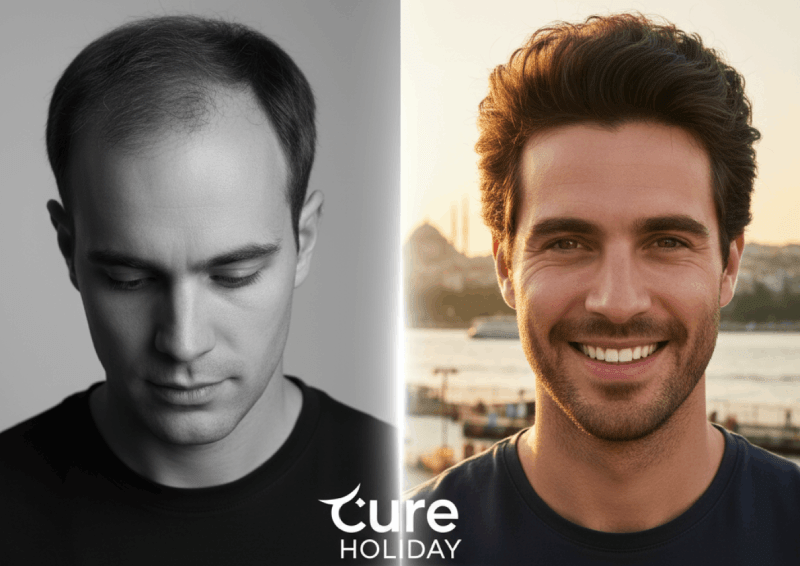What Is FUE Hair Transplant?
FUE (Follicular Unit Extraction) is a hair transplant method based on the principle of extracting hair follicles one by one from the donor area and transferring them to the area of implantation. During this procedure, specially designed micromotors or manual tools are used. Each hair follicle, along with the surrounding tissue, is removed with a cylindrical incision, so no strip-shaped scar remains. Since it is a minimally invasive method, the healing process is faster, and the possibility of leaving a scar in the donor area is very low. It is ideal, especially for transplanting into small areas.
What Is FUT Hair Transplant?
FUT (Follicular Unit Transplantation) is a traditional hair transplant method where a strip of hair-bearing skin is removed from the donor area (usually the back of the head). This strip is divided into smaller grafts (groups of hair follicles) under a microscope and then implanted into the channels in the bald area. This method allows for the transfer of more grafts in a single session and is generally preferred for patients with more advanced hair loss. However, since a strip is removed, a stitch line remains in the donor area.
What Is DHI Hair Transplant?
DHI (Direct Hair Implantation) is one of the newest methods used in hair transplantation. In this technique, hair follicles are harvested from the donor area using a special tool called the Choi Pen and are directly implanted into the bald area without waiting. Unlike FUE, in DHI, channels are not opened beforehand; the hair follicle is placed with a special tool that performs both the channel opening and the implantation at the same time. This method aims to achieve a more natural and denser look by increasing the density of the implantation.
What Is the Difference in Donor Area Graft Harvesting Method?
The graft harvesting methods in FUE and DHI are similar; in both techniques, hair follicles are harvested one by one. While micromotors are generally used in FUE and DHI, special Choi pens can also function as a harvester in DHI. In the FUT method, hair follicles are obtained not one by one, but by removing a strip of hair-bearing skin. This fundamental difference is a determining factor in whether a scar remains in the donor area and the healing process.
What Is the Difference in Graft Implantation Method?
The implantation methods in FUE and DHI show significant differences. In FUE, micro-channels are opened in the bald area beforehand, and the harvested grafts are placed into these channels. In the DHI method, no channel opening is performed; the hair follicles are directly injected into the skin with a special pen (Choi Pen). In the FUT method, micro-channels are also opened, but these channels can be larger. The biggest advantage of DHI is that it makes the implantation process more precise and faster.
Which Method Leaves the Most Scars?
The FUT (Follicular Unit Transplantation) method leaves a thin and linear stitch scar where the strip of skin is removed from the donor area. This scar can become noticeable when the hair is cut short. In the FUE and DHI methods, since hair follicles are harvested one by one, only punctate scars form. These punctate scars almost completely disappear by the end of the healing process and are difficult to notice even when the hair is cut very short.
Which Method Has a Faster Donor Area Healing Time?
The donor area healing process in the FUE and DHI methods is much faster than in FUT. This is because the incisions made in FUE and DHI are at a micro-level and punctate, which minimizes tissue damage. Generally, in these methods, the donor area scabs over within a few days and heals completely within one to two weeks. In FUT, because stitches are used, the healing process can be longer and more painful.
Which Method Is More Suitable for Large Areas?
When hair needs to be transplanted into large bald areas, the FUT method is generally more suitable. FUT allows for a large number of grafts (approximately 4000-5000 grafts) to be harvested in a single session. This way, more grafts can be transplanted in a single operation for patients with advanced hair loss. FUE and DHI methods can also be used for large areas, but the number of sessions may increase, and the operation may take longer.
Which Method Is More Suitable for Smaller and Targeted Areas?
The DHI method is ideal for smaller and targeted areas like densifying the hairline, or for beard or eyebrow transplants. Thanks to the Choi pen, hair follicles can be placed much more precisely in the desired angle and direction. This provides a great advantage in achieving a natural look. FUE is also quite suitable for small areas, but it may not achieve the implantation density that DHI offers.

Is It Necessary to Shave the Head for FUE?
Yes, for the FUE method, the donor area, which is usually the entire head, needs to be shaved. This allows for the easier and healthier harvesting of hair follicles. Shaving is a critical step to minimize potential damage to the grafts during harvesting. Shaving the hair also helps the operation be completed more quickly and efficiently.
Is It Necessary to Shave the Head for FUT?
For the FUT (Follicular Unit Transplantation) method, it is not necessary to shave the entire head. It is sufficient to shave only the donor area from which the strip of hair-bearing skin will be taken. After the strip is removed, stitches are placed in this area, and the hair above it covers the stitch line. This provides a significant advantage for patients who use their hair long and do not want the surgical scar to be visible.
Is It Necessary to Shave the Head for DHI?
In the DHI (Direct Hair Implantation) method, it may not be necessary to shave the entire head, depending on the area where the operation will be performed. Shaving only the donor area is usually sufficient. Additionally, in some cases, implantation can be performed without shaving the head using special tools. This makes DHI an attractive option especially for female patients who use their hair long or patients who will have a transplant in a very small area.
Which Method Has the Highest Graft Survival Rate?
The graft survival rate is one of the most important factors determining the success of a hair transplant operation. The DHI method offers the highest graft survival rate because it minimizes the air exposure time of the harvested hair follicles. While grafts are kept outside for a while in the FUE and FUT methods, in DHI, the follicles are implanted directly. This helps the follicles stay healthier and stronger. However, in the hands of an experienced surgeon, high success rates can be achieved with all methods.
Which Method Takes Longer?
The duration of a hair transplant operation depends on the number of grafts to be implanted and the method used. Generally, the DHI and FUE methods take longer than FUT. This is because in these methods, each hair follicle is harvested and implanted one by one, which is a time-consuming process. A 4000-graft FUE or DHI operation can take 8 to 10 hours. FUT can be completed more quickly thanks to the removal of a strip from the donor area.
Which Method Is More Suitable for Female Hair Transplants?
Hair transplantation in women is usually performed to increase hair density rather than to cover completely bald areas as in men. Therefore, the DHI method, which does not require shaving the entire head, or the FUE method, which involves partial shaving, may be more suitable. DHI offers a more natural result thanks to its ability to implant among existing hair. However, the most suitable method is still determined by the doctor based on the level of hair loss.
What Is the Cost of FUE Hair Transplant in Turkey?
Turkey is a worldwide center for FUE hair transplantation. Prices generally vary according to the number of grafts, the quality of the clinic, and the experience of the doctor. On average, the cost of an FUE hair transplant ranges between €1,500 and €3,000. This price usually includes the entire process (consultation, operation, medication, shampoo, and a one-year follow-up). Prices are much more affordable than in Western European countries, which makes Turkey attractive.
What Is the Cost of FUT Hair Transplant in Turkey?
Although the FUT method has become less popular, it is still preferred in some cases. The cost of a FUT hair transplant in Turkey is generally lower compared to FUE. Average prices can range from €1,000 to €2,500. The main reason for the more affordable price is the shorter operation time and the lower need for technological equipment. Nevertheless, the FUT method is less preferred as it involves a surgical incision.
What Is the Cost of DHI Hair Transplant in Turkey?
The DHI method is generally more costly than FUE and FUT because it requires special pens and a more precise process. The average cost of a DHI hair transplant in Turkey ranges from €2,000 to €4,500. This pricing is often explained by the higher graft survival rates and the possibility of denser implantation it offers. There may be a price difference from clinic to clinic, so it is important to do a comprehensive research.
Which Method Is More Suitable for a Denser Hairline?
The DHI method is ideal for creating the densest hairline because it allows hair follicles to be implanted much closer and more densely. The special Choi pen is placed with millimeter precision in the implantation area, which provides a natural and dense appearance. Successful hairlines can also be created with FUE and FUT, but it may be more difficult to achieve the density level that DHI offers.
Can FUE and FUT Be Performed at the Same Time?
Yes, FUE and FUT methods can be combined at the same time. This complex operation is applied especially to patients with a limited donor area or those who need a very large number of grafts. First, a large strip of grafts is taken with FUT, and then the remaining grafts are harvested with the FUE method. This combination maximizes the potential of the donor area and allows the highest possible number of grafts to be reached in a single session.
What Are the Advantages of the FUE Method?
The biggest advantage of the FUE method is that it does not leave a visible scar after the operation. Thanks to the punctate harvesting, the healing process is fast and painless. It is ideal for patients who prefer a shaved hairstyle. Additionally, the ability to harvest and implant hair follicles from other parts of the body (beard, chest) is a significant advantage of FUE. Being minimally invasive offers a more comfortable experience for patients.
What Are the Disadvantages of the FUE Method?
The disadvantages of the FUE method include that it takes longer to harvest a large number of grafts to cover a large area. Also, since each follicle is harvested one by one, it requires more time and effort, so the operation time is longer. In case of excessive harvesting of hair follicles from the donor area, thinning may be observed in that area. FUE may not be a suitable method for every patient’s needs.
What Are the Advantages of the FUT Method?
The biggest advantage of the FUT method is its ability to transfer the highest number of grafts in a single session (usually 4000-5000 grafts). This allows for a quick result in patients with advanced hair loss. Compared to FUE, the operation time can be shorter. Also, since the hair follicles are harvested in a strip, they are less sensitive, and the post-implantation survival rates are generally high.
What Are the Disadvantages of the FUT Method?
The most significant disadvantage of FUT is that it leaves a permanent and linear stitch scar in the donor area. This scar can be an aesthetic problem, especially for patients who want to use their hair short. Also, the post-operative healing process can be more painful and longer than FUE. Since it is a stitched operation, the risk of infection is also higher. Therefore, it is less preferred by patients.
What Are the Advantages of the DHI Method?
The biggest advantage of DHI is that it offers the possibility of a denser and more natural implantation. The fact that the channel opening and implantation are done at the same time shortens the waiting time of the grafts outside and increases the survival rate. There is no obligation to shave the entire head. The operation is ideal, especially for patients who want to increase hair density or have implantation among existing hair.

What Are the Disadvantages of the DHI Method?
The disadvantages of the DHI method are that it is generally more costly and the operation time is longer. The use of a special Choi Pen causes the operation to require more technical skill and experience. The number of grafts that can be implanted in a single session may be less than FUE. Therefore, it may not be preferred in situations where a very large area needs to be implanted.
Which Method Is Suitable for Patients with a Weak Donor Area?
The most suitable method for patients with a weak donor area is FUE. FUE allows hair follicles to be harvested not only from the scalp but also from other parts of the body such as the beard and chest. This provides an alternative solution when the head donor area is insufficient. The FUT and DHI methods may be insufficient in these patients as they are dependent only on the donor area at the back of the head.
How Is the Donor Area Prepared for Each Method?
For FUE and DHI, the donor area is shaved and numbed with a local anesthetic before the operation. This allows for the easy harvesting of hair follicles. In the FUT method, only the area where the incision will be made is shaved, and a local anesthetic is applied. After the strip is removed, the remaining hair hides the stitch line. The correct preparation of the donor area is of critical importance for the success of the operation.
How Is the Implantation Area Prepared for Each Method?
In the FUT and FUE methods, micro-channels where the hair follicles will be placed are opened in the implantation area beforehand. The direction, depth, and angle of these channels are of great importance for obtaining a natural look. In the DHI method, no channel opening is performed beforehand for the implantation area. The hair follicles are injected directly into the implantation area with a special pen, which provides a more controlled implantation process.
Is the Pain Level Different for Each Procedure?
Yes, the pain level is different in each procedure. The least painful methods are FUE and DHI because no surgical incision is made in these methods. While the patient does not feel any pain during the operation as a local anesthetic is applied, there may be a slight pain or sensitivity afterward. The FUT method, on the other hand, involves a surgical incision, so the post-operative pain level is higher and may last longer.
When Is the Final Result Visible for Each Method?
There is no major difference in the time it takes for the final results to be visible among hair transplant methods. Generally, a “shock loss” is experienced within the first 2-3 weeks after the transplant, which is normal. New hairs begin to grow after 3-4 months, and a noticeable change is seen at 6 months. The final results are visible within 12 to 18 months. This process is the necessary time for the hair follicles to grow healthily.
Is Post-Operative Care Different?
Post-operative care is similar for all three methods, but in FUT, special attention should be paid to the stitch line. In the first few days, it is important not to get water on the donor and implantation areas, avoid strenuous activities, and be careful about the sleeping position. In FUE and DHI, daily life can be resumed earlier as healing is faster. In FUT, it may take longer for the stitches to be removed and for the healing process to be completed.
Which Method Is More Suitable for a Second Hair Transplant?
The most suitable method for a second hair transplant is generally FUE. This is because the FUE method, by harvesting follicles one by one from the donor area, offers the possibility of harvesting grafts from areas that were not damaged in the first operation. Especially if FUT was performed in the first operation, it may be possible to hide the scar and perform a new hair transplant with FUE. This makes FUE a versatile option.
Can Body Hair Be Used in These Procedures?
Yes, when the donor area is insufficient, hair follicles can be harvested from other parts of the body such as the beard, chest, or back with the FUE method. Although these follicles may not be as thick and durable as the hair follicles from the back of the head, they can be used to increase hair density. Especially beard follicles can give good results due to their thick structure. In the FUT and DHI methods, body hair is generally not used.
What Are the Factors That Affect Which Method Is Chosen?
The choice of method depends on many factors. These include the level of hair loss, the condition of the donor area, the patient’s hair structure, budget, and expectations. For example, for a patient who wants to use their hair short, FUE or DHI may be more suitable, while for a patient who needs a lot of grafts, FUT may be more logical. The decision-making process is determined according to the patient’s specific situation after a detailed doctor’s examination.



